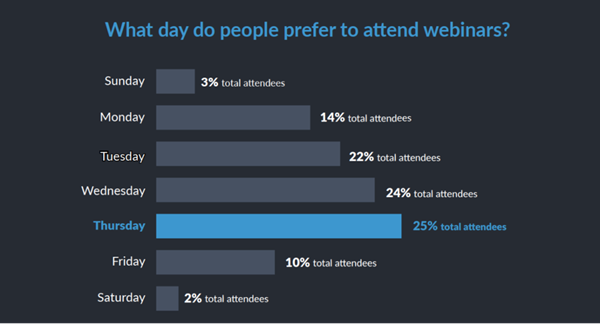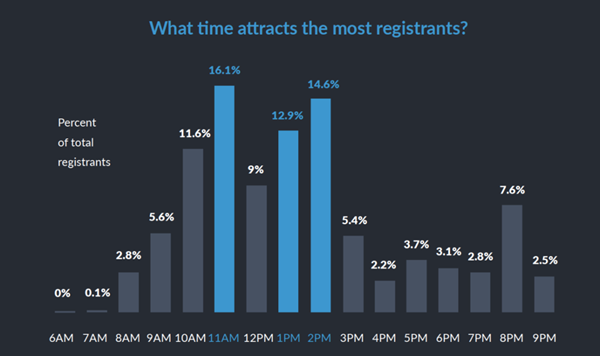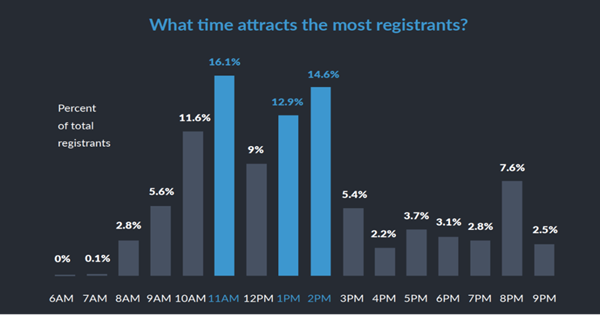Some things just work better at certain times. The perfect time for a walk on the beach: sunset. The perfect time to do holiday shopping online: Cyber Monday. The perfect time for a cup of coffee: first thing in the morning.
The same rules apply to webinars – certain days and times work better when trying to attract the largest audience possible.
Based on our experience and data from thousands of webinars, we’ve learned a few things about what people want when it comes to the day and time of a webinar.
Here are seven scheduling tips that will help you boost webinar registrations.
1. Schedule in the middle of the week
People prefer to attend webinars on Tuesdays, Wednesdays, and Thursdays.

Just remember, since these are preferred webinar days, you’ll be competing with other webinars, not to mention hectic mid-week schedules.
2. Plan it for 11 a.m.
The 11 a.m. slot usually gets the highest percentage of registrants, and 2 p.m. comes in at a close second. As a rule, 11 a.m. to 2 p.m. are the best times to host a webinar. The only exception within that time frame is noon—don’t mess with people’s lunch hour.

3. Remember both coasts
One of the best things about webinars is that you can connect with people all over the country and even the world. The downside is trying to accommodate everyone’s schedule.
If you have attendees in multiple time zones, the best time for a webinar is 12 p.m. PST/3 p.m. EST. I know, I know, this breaks the lunchtime rule, but sometimes you have to break the rules for the greater good.
4. Host a pre-recorded event instead
When multiple time zones are an issue, the best solution may be a pre-recorded event. Not only is it more convenient for attendees, but you can more easily accommodate organizer and presenter schedules. All you have to do is pre-record your webinar, then schedule it to run once or multiple times. You can still include polls and even host a live Q&A at the end.
5. Host longer webinars
We’re often afraid to inconvenience our attendees, which leads us to create shorter webinars that take up as little time as possible. However, this isn’t always what your audience wants. People are actually excited about longer webinars. In fact, 60-minute webinars attract 2.1 times more registrants than 30-minute webinar!
Longer webinars indicate you’re going to dive deep into a topic and provide actionable takeaways and valuable insights.
6. Email webinar invites on Tuesdays
We found that 24% of all webinar registrations occur on Tuesdays. Schedule your invitation emails to drop Tuesday morning — Tuesday at 9:00 am gets the best response.
 />
/>
7. Don’t forget to go on-demand
Spoiler alert: people are busy. If something comes up in their schedule, your webinar will get bumped. But you don’t have to lose those registrants or attendees because of a scheduling conflict. Share your recorded webinar so attendees can rewatch, and registrants who couldn’t attend can watch for the first time. You can also get way more value from your webinar when or promote you continue to promote the on-demand version to new audiences.
The key takeaway — to maximize your audience, schedule webinars for 11 a.m. on a Thursday. But remember, webinars aren’t one-size-fits-all so try to choose the best option for the majority of your audience. And if all else fails, provide an on-demand webinar to make everyone happy.
New to webinars? Here are best practices for how to create, host and schedule a webinar to ace your first online event.






